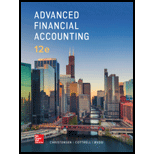
Intercompany sale of bonds: when a company sells bonds to its subsidiary, all effects of the intercompany indebtedness must be eliminated. A company cannot report an investment in its own bonds to itself. Thus when the consolidated entity is viewed as a single company, all amounts associated with intercompany indebtedness must be eliminated, including investment in bonds, the bonds payable any unamortized discount or premium, the interest income or expenses on the bonds and any accrued interest receivable or payable.
Retirement of bonds: when a constrictive retirement occurs, the consolidated income statement for the period reports a gain or loss on retirement, but not reported in consolidated
The consolidation entries to remove the effects of intercompany bond ownership in preparing consolidated financial statements.
b
Intercompany sale of bonds: when a company sells bonds to its subsidiary, all effects of the intercompany indebtedness must be eliminated. A company cannot report an investment in its own bonds to itself. Thus when the consolidated entity is viewed as a single company, all amounts associated with intercompany indebtedness must be eliminated, including investment in bonds, the bonds payable any unamortized discount or premium, the interest income or expenses on the bonds and any accrued interest receivable or payable.
Retirement of bonds: when a constrictive retirement occurs, the consolidated income statement for the period reports a gain or loss on retirement, but not reported in consolidated balance sheet. If the company purchases the bond of an affiliate from an unrelated party at a price equal to the liability reported, the elimination entries required to be prepared in consolidated financial statement.
The consolidation entries to remove the effects of intercompany bond ownership in preparing consolidated financial statements in the next year 20X6.
Want to see the full answer?
Check out a sample textbook solution
Chapter 8 Solutions
EBK ADVANCED FINANCIAL ACCOUNTING
- Please provide the accurate answer to this general accounting problem using appropriate methods.arrow_forwardAccurate Value Hardware began in 2019 with a credit balance of $87,000in the allowance for sales returns account. Sales and cash collections from customers during the year were $963,000 and $715,000, respectively. Accurate Value estimates that 7.5% of all sales will be returned. In 2019, customers returned merchandise for a credit of $36,000 to their accounts. Accurate Value's 2019 income statement would report net sales of__.arrow_forwardThe financial statements of Sunland Manufacturing Company report net sales of $1277500 and accounts receivable of $71000 and $69000 at the beginning and end of the year, respectively. What is the average collection period for accounts receivable in days?arrow_forward
- Accounting answerarrow_forwardPlease help me solve this general accounting problem with the correct financial process.arrow_forwardLaura estimates that his car costs $290 per month in fixed expenses, such as insurance and registration. Additionally, he calculates gas, oil, and maintenance at 16 cents per mile. Laura typically drives 1,250 miles each month on average. How much would Laura expect his total car costs to be in May if he drives 1,680 miles? help mearrow_forward
 Intermediate Accounting: Reporting And AnalysisAccountingISBN:9781337788281Author:James M. Wahlen, Jefferson P. Jones, Donald PagachPublisher:Cengage Learning
Intermediate Accounting: Reporting And AnalysisAccountingISBN:9781337788281Author:James M. Wahlen, Jefferson P. Jones, Donald PagachPublisher:Cengage Learning Financial AccountingAccountingISBN:9781305088436Author:Carl Warren, Jim Reeve, Jonathan DuchacPublisher:Cengage LearningPrinciples of Accounting Volume 1AccountingISBN:9781947172685Author:OpenStaxPublisher:OpenStax College
Financial AccountingAccountingISBN:9781305088436Author:Carl Warren, Jim Reeve, Jonathan DuchacPublisher:Cengage LearningPrinciples of Accounting Volume 1AccountingISBN:9781947172685Author:OpenStaxPublisher:OpenStax College College Accounting, Chapters 1-27AccountingISBN:9781337794756Author:HEINTZ, James A.Publisher:Cengage Learning,
College Accounting, Chapters 1-27AccountingISBN:9781337794756Author:HEINTZ, James A.Publisher:Cengage Learning, Cornerstones of Financial AccountingAccountingISBN:9781337690881Author:Jay Rich, Jeff JonesPublisher:Cengage Learning
Cornerstones of Financial AccountingAccountingISBN:9781337690881Author:Jay Rich, Jeff JonesPublisher:Cengage Learning





